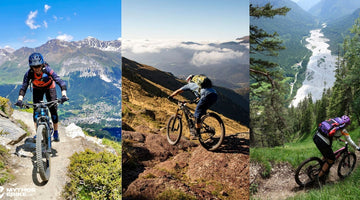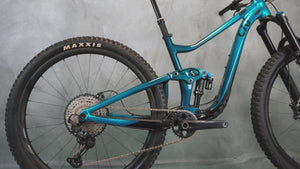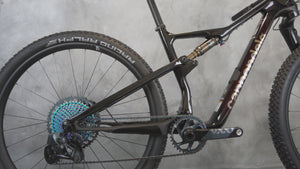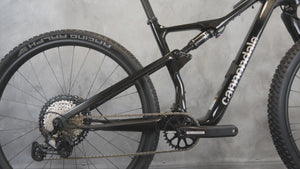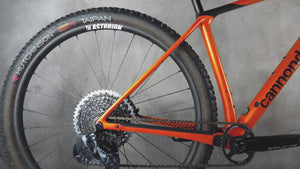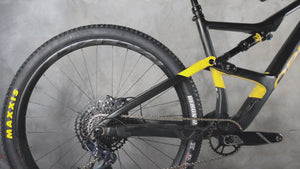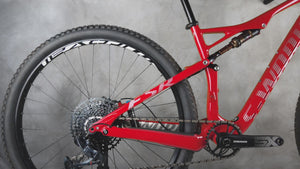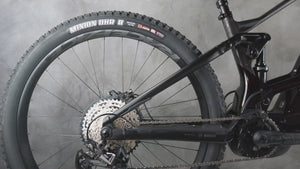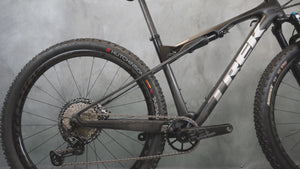Top Criteria for Choosing your Electric Mountainbike
In this Article
Posted on February 14, 2022
The electric MTB market is booming, but buying its first electric mountain bike can be a puzzle, given the number of brands and options available. How to navigate? Follow the guide and find 8 criteria for choosing the electric MTB that best suits you!
The quality of the engine

Some trademarks are distinguished in the field of electrical mountain bikes because they each bring their own advantages. Here is a list of engines tested and approved:
- Bosch - Once you have started looking at mountain bike engines, you will certainly fall on the term "Bosch Performance Line". Bosch engines are known for their performance on accident and technical land.
The brand is also leader in the field of intermediate drive engines, distinguished by the different power modes that the cyclist can easily activate while driving.
- Shimano - This brand privileges compactness and therefore opts for the manufacture of smaller engines in general to reduce the center of gravity of the electric bike (which is essential to give it this authentic mountain bike sensation). This is also reflected in lower weight. For those who prefer to have a more conventional bike.
The disadvantage of these engines is that they are often not as powerful as the Bosch engines, with a much lower torque. You may appreciate them more if your driving style involves less frequent activations of electrical assistance.
- Yamaha - Many recent Yamaha engines integrate as much technology as possible. For those who wish to follow the statistics of their engine by Bluetooth while they roll, Yamaha is a pioneer of this type of technology.
Do not forget however that some well-established electric bicycle brands, such as Specialized, design and manufacture their own engines. It is always useful to look at how they work (and meet your requirements) rather than based solely on the brand to judge quality.
Engine location

At the beginning of the development of electrical mountain bikes, some models were equipped with a hub engine on the rear wheel. However, as these engines tend to overheat rapidly in the climbs and that the weight distribution is very uneven, this option has almost completely disappeared from the market. The hub engines are no longer used on some very low-end models and some electric road bikes. Good quality mountain biking all have a central engine.
Battery life

The autonomy of electric MTBs strongly depends countless factors, whose battery capacity, the selected assistance mode, the weight of the cyclist and the elevation profile of the route. It is very difficult to make an estimate on autonomy. It can vary between 10 km (with a complete charge, in the highest mode and only in climb) and more than 100 km (with moderate assistance and frugal and efficient driving).
Important: The capacity of the battery can not be considered alone, but should be considered in the context of the power (maximum) of the engine. A battery of 630 Wh on a powerful mountain bike as Habike XDURO NDURO 10.0 will empty more quickly to maximum assistance than a 320 Wh battery on a light mountain bike as the specialized Levo SL.
500WH is the standard battery size for most electric bikes. High performance electric road bikes often use smaller batteries of 250WH to reduce weight.
Most batteries are easy to remove and it takes three to five hours to recharge them completely. If you use your electric bike in an intensive way or if you perform extreme journeys over long distances, you still have the option to buy additional chargers or batteries.
Integral suspension or hardtail?

Unlike full suspension bikes, the hardtails do not suspension at the back. The hardtails are suitable for cyclists who borrow all the bike paths, the Gravel, the grounds and the more groomed trails. The electric suspension electric bicycles are more common and improve comfort and traction on accident and technical lands.
Electric mountain bikes with integral suspension can be classified into three categories based on suspension travel: 111-130 mm, 131-150 mm and 151-170 mm.
Bikes in shorter travel (110-130 mm) will be more agile and playful, especially on smooth and fluid tracks, while longer travel bicycles (151-170 mm) will be stronger and efficient on the tracks of accident descent. The medium travel bikes (131-150 mm) attempt to gather the best of both worlds.
The travel must be adapted to the field and your driving style. In general, the more the trails are accident, steep and technical, the more the debt must be important.
The price
Depending on the manufacturer, a reliable electrical mountain mountain bike will cost at least 3000 €, but there is not really limit. Hardtails are usually about 1000 € cheaper. The cheapest options often compromise in components, engine or frame. This lower quality translates into lower than average driving performance and a lifetime often much shorter.
Wheel size

Currently, almost all powerful electrical mountain bikes drive on 29 "wheels with a maximum width of 2.6". An option that becomes more and more popular is to have closer front wheels of 29 "and larger rear wheels of 27.5" (MX concept). Bicycles with 27.5 "wheels at the front and back are increasingly rare. Each configuration has its advantages and disadvantages, but we find that the MX concept is a good compromise. The main disadvantages are the faults and the spare parts, because you will always have to carry two different sizes and will not be able to exchange the front and rear tires. The Super Gravity tires of Schwalbe or Double Down of Maxxis are our favorite choice for the accident trails, on the Fluid trails, a lighter alternative will do the trick.
Aluminum or carbon frame?
The choice of the frame material will be above all a budget issue. On average, electric carbon mountain bikes are about 1000 € more expensive than aluminum comparable models. The advantages of a carbon frame in terms of driving performance are minimal. A good carbon frame can be more rigid and gain 500 to 600g by weight, but this weight is not as important for MTBs as for conventional bikes. The carbon gives manufacturers greater freedom in the design of the frame, which makes it possible to obtain a more beautiful and better integrated bike. Ultimately, the decision to buy a carbon electric mountain bike is purely emotional.
How many speeds does an electric mountain bike need?

The time when mountain bikes had 27 or even 30 speeds is over. Modern bicycles, with or without electrical assistance, have only one tray at the front and rely on transmissions of 8 to 12 speeds, which cover a similar range of speeds while passing the speeds more reliable. However, if the range of the cassette is too weak, you will miss an easier relationship in the steep climbs. A range of 500% is ideal.
A few words to conclude
If it is always important to take into account fundamental factors such as battery and motor when choosing an electric MTB (they dictate more or less its price after all), you must not make the purpose of your decision. . Try to focus on how the bike will meet your needs and ensure you a satisfactory driving experience.
This summarizes the way you can get the most out of your money when buying these electric bikes, most often expensive.















